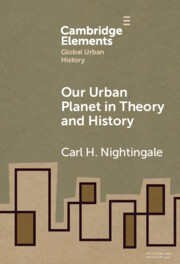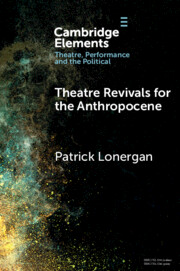226 results
Chapter 6 - Animal Abstinence in the Anthropocene
-
- Book:
- Vegetarianism and Veganism in Literature from the Ancients to the Twenty-First Century
- Published online:
- 30 May 2024
- Print publication:
- 06 June 2024, pp 174-205
-
- Chapter
- Export citation
International Relations and the non-human: Exploring animal culture for global environmental governance
-
- Journal:
- Review of International Studies , First View
- Published online by Cambridge University Press:
- 27 May 2024, pp. 1-20
-
- Article
-
- You have access
- Open access
- HTML
- Export citation
Chapter 35 - Goethe and Our Endangered Natural World
- from Part VI - Goethe’s Lasting Significance
-
-
- Book:
- Goethe in Context
- Published online:
- 16 May 2024
- Print publication:
- 23 May 2024, pp 341-349
-
- Chapter
- Export citation
Chapter 15 - The Time of New Histories
-
-
- Book:
- The Cambridge Companion to American Utopian Literature and Culture since 1945
- Published online:
- 09 May 2024
- Print publication:
- 16 May 2024, pp 271-286
-
- Chapter
- Export citation

Our Urban Planet in Theory and History
-
- Published online:
- 14 May 2024
- Print publication:
- 06 June 2024
-
- Element
- Export citation
3 - Decentring the human
-
- Book:
- Re-imagining Social Work
- Published online:
- 07 December 2023
- Print publication:
- 21 December 2023, pp 30-52
-
- Chapter
- Export citation
39 - The Essay and the Anthropocene
- from Part IV - Toward the Contemporary American Essay (2000–2020)
-
-
- Book:
- The Cambridge History of the American Essay
- Published online:
- 28 March 2024
- Print publication:
- 14 December 2023, pp 668-682
-
- Chapter
- Export citation
4 - Industrialization: The Great Acceleration
- from Part II - The State We’re in and How We Got There
-
- Book:
- Sustainability Science
- Published online:
- 07 December 2023
- Print publication:
- 07 December 2023, pp 66-90
-
- Chapter
- Export citation
3 - Early States and Civilizations
- from Part II - The State We’re in and How We Got There
-
- Book:
- Sustainability Science
- Published online:
- 07 December 2023
- Print publication:
- 07 December 2023, pp 39-65
-
- Chapter
- Export citation
Chapter 12 - Indigeneity
- from Part II - Contexts and Controversies
-
-
- Book:
- The Cambridge Companion to Literature and Animals
- Published online:
- 26 October 2023
- Print publication:
- 09 November 2023, pp 220-235
-
- Chapter
- Export citation
Chapter 4 - Decolonizing Literary Pedagogies in Australia and Aotearoa New Zealand
- from Part I - Identities
-
-
- Book:
- Decolonizing the English Literary Curriculum
- Published online:
- 02 November 2023
- Print publication:
- 09 November 2023, pp 80-109
-
- Chapter
-
- You have access
- Open access
- HTML
- Export citation
22 - Citizenship and Nationhood: From Antiquity to Gaia Citizenship
- from Part III - Intersections: National(ist) Synergies and Tensions with Other Social, Economic, Political, and Cultural Categories, Identities, and Practices
-
-
- Book:
- The Cambridge History of Nationhood and Nationalism
- Published online:
- 08 November 2023
- Print publication:
- 09 November 2023, pp 485-502
-
- Chapter
- Export citation
Excavating the field of heritage law: support, renewal, and iconoclasm
-
- Journal:
- International Journal of Cultural Property , First View
- Published online by Cambridge University Press:
- 07 November 2023, pp. 1-16
-
- Article
- Export citation
Chapter 29 - Travel Writing
- from Part III - Themes and Influences
-
-
- Book:
- W. G. Sebald in Context
- Published online:
- 24 August 2023
- Print publication:
- 07 September 2023, pp 256-264
-
- Chapter
- Export citation
Chapter 8 - “Only Nature Is a Thing Unreal”: The Anthropocene 1890s
-
-
- Book:
- Nineteenth-Century Literature in Transition: The 1890s
- Published online:
- 17 August 2023
- Print publication:
- 07 September 2023, pp 170-186
-
- Chapter
- Export citation
Chapter 12 - Natural History and the Anthropocene
- from Part II - The Literary Works
-
-
- Book:
- W. G. Sebald in Context
- Published online:
- 24 August 2023
- Print publication:
- 07 September 2023, pp 102-109
-
- Chapter
- Export citation
Chapter 1 - Introduction
-
- Book:
- Planetary Pynchon
- Published online:
- 24 August 2023
- Print publication:
- 24 August 2023, pp 1-21
-
- Chapter
- Export citation
Problematising entanglement fetishism in IR: On the possibility of being without being in relation
-
- Journal:
- Review of International Studies , First View
- Published online by Cambridge University Press:
- 23 August 2023, pp. 1-15
-
- Article
-
- You have access
- Open access
- HTML
- Export citation

Theatre Revivals for the Anthropocene
-
- Published online:
- 18 August 2023
- Print publication:
- 14 September 2023
-
- Element
- Export citation
9 - Conclusions
- from Part IV - Conclusions
-
- Book:
- Making Global Society
- Published online:
- 27 July 2023
- Print publication:
- 10 August 2023, pp 413-426
-
- Chapter
- Export citation



